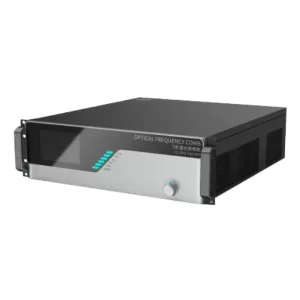Introduction
A femtosecond laser frequency comb (often just “frequency comb”) is a spectrum of thousands to millions of discrete, equally spaced optical frequencies produced by a mode-locked femtosecond laser[1][2]. In the time domain this is a train of ultrashort pulses; in the frequency domain it appears as a “comb” of narrow, phase-coherent optical lines[2][3]. Crucially, all comb lines share a fixed phase relationship and uniform spacing, so measuring the absolute frequency of one tooth and the two degrees of freedom of the laser completely determines the whole comb[1][4]. In practice, this lets us use the comb as an optical ruler to link optical frequencies (hundreds of THz) to radio/microwave frequencies (MHz–GHz)[5][6]. By “counting” optical cycles via microwave electronics, combs have revolutionized precision metrology, making it possible to measure optical frequencies with unprecedented accuracy[7][8]. (This capability earned John Hall and Theodor Hänsch the 2005 Nobel Prize in Physics for the optical frequency comb technique[9][10].) Today, frequency combs are central to optical atomic clocks, precision spectroscopy, and many emerging technologies.
Operating Principles of frequency comb
Femtosecond combs are generated by mode-locked lasers whose pulses create a broad, regular spectrum. Each pulse leaves the cavity after one round trip, producing a pulse repetition rate (where is the cavity round-trip time) that sets the spacing between comb teeth[11][12]. In the frequency domain, every optical mode of the laser can be written as
νn=nfr+f0
where is a large integer (typically – ), and is the carrier–envelope offset (CEO) frequency[4][12]. Physically, is easily measured by detecting the pulse train on a fast photodiode (giving an electrical signal at the pulse repetition frequency)[13], whereas arises from the slip between the pulse envelope and the carrier wave each round trip. To measure , the comb spectrum is broadened to an octave and a self-referencing -to- interferometer is used[13][14]. In an -to- scheme, the low-frequency end of the comb is frequency-doubled and beat against the high-frequency end, producing a beat note equal to [14]. Once and are known (and locked), every comb tooth’s absolute frequency is determined[15][12].
Frequency comb systems stabilize both and with feedback loops. The laser cavity length (or pump) is adjusted to lock to an RF reference, and the dispersion or pump power is adjusted to fix [16][17]. When fully stabilized, the comb lines inherit the stability of the reference: state-of-the-art combs achieve fractional stability and accuracy better than 10 [18][19]. In sum, a comb is like a clockwork: provides the coarse grid spacing and the fine offset[4][19]. Modern comb lasers are designed to produce octave-spanning spectra (often via nonlinear fibers) so that can be detected, and employ polarization-maintaining, fiber-coupled outputs for robustness.
Key Points (Operating Principles):
– A femtosecond comb is produced by a mode-locked laser whose pulses produce equidistant spectral lines[2][4].
– Repetition rate sets the comb spacing; it is measured on a photodiode and locked to an RF clock[11][13].
– Carrier–envelope offset is the comb’s overall offset; it is measured (often via -to- self-referencing) and locked to a reference[13][14].
– Once and are known/stabilized, all comb teeth (frequencies ) are precisely defined[15][12].
Development History and Technological Advancements
The concept and realization of frequency combs evolved from decades of ultrafast laser research. In the 1970s, researchers like Hänsch (Stanford/Garching) first built mode-locked lasers with pulse durations on the order of picoseconds or femtoseconds[20]. Chebotayev’s group in Novosibirsk used short-pulse lasers as early crude combs in the 1970s, aiming for high-precision spectroscopy[20]. The 1980s saw the advent of Kerr-lens mode-locking (KLM) and Ti:sapphire lasers, which produced sub-100 fs pulses routinely. For example, the first Ti:sapphire lasers appeared in the mid-1980s and by the early 1990s were commercially available.
Meanwhile, precision frequency measurement was being pursued via chains of frequency multipliers and modulators. In the late 1980s, Kourogi and co-workers demonstrated “comb generators” using intracavity modulators[21], and Hänsch’s group used microwave chains to span optical domains. However, these methods were complex. The breakthrough came in 1999–2000, when several groups (at NIST, JILA, Max-Planck, etc.) demonstrated the first self-referenced femtosecond combs that could link optical frequencies directly to microwaves[22]. In 1999, Jun Ye and co-workers (NIST/Colorado) and Steve Diddams (NIST) showed octave-spanning, self-referenced combs from Ti:sapphire lasers; Hall, Hänsch, and Ye used them to measure a hydrogen transition frequency[22][20]. These experiments proved the “optical clockwork” concept: a comb simplified the frequency chain to a single laser system. As a result, conventional atomic clock lasers at ~500 THz could be counted down to the microwave domain[22][16]. For this work, John Hall and Theodor Hänsch were awarded the 2005 Nobel Prize in Physics[9][10].
From 2000 onward, comb technology matured rapidly. Fiber-laser-based combs (especially erbium-doped fiber at 1550 nm) became popular due to their turnkey operation and telecom-wavelength compatibility[23]. Researchers developed supercontinuum generation in photonic-crystal fibers to span octaves[24], and integrated designs like fully fiber-coupled combs. In 2005, vacuum-ultraviolet combs were demonstrated via high-harmonic generation in femtosecond cavities[25]. More recently, dual-comb techniques have emerged, using two combs with slightly different spacings for high-resolution spectroscopy without moving parts. Microresonator Kerr-combs (based on nonlinear microcavities) have also appeared in the 2010s, producing combs with mode spacings up to tens of GHz[26][27]. These chip-scale combs offer high line spacing for astronomy and telecom applications[28], though most are not yet octave-spanning.
Meanwhile, commercial comb systems have improved in performance and integration. Modern mode-locked fiber lasers achieve sub-Hz comb-line linewidths and ultra-low integrated phase noise. For example, a typical high-end Er-fiber comb now achieves <1×10 fractional stability in 1 s and integrated phase noise <100 mrad[18][29]. Companies like Menlo and Toptica have developed turnkey comb sources; academic groups continue pushing combs into new spectral regions (mid-IR, UV) and platforms (microchips). A timeline of key milestones:
- 1977:First mode-locked “femtosecond” dye lasers (∼1 ps pulses) demonstrated[20].
- 1985–1990:Development of Kerr-lens mode-locked Ti:sapphire lasers (tens of fs pulses).
- Late 1980s:Early comb concepts via modulators (Koenig/Kourogi) and frequency chains (Hänsch).
- 1999:First self-referenced femtosecond combs (Ye/NIST, Diddams et al.) enabling optical-frequency measurement[22].
- 2005:Nobel Prize awarded for comb spectroscopy[9]; commercialization of comb lasers begins.
- 2010s:Fiber-laser combs (Er, Yb) become reliable and compact; advent of dual-comb spectroscopy and microresonator (“Kerr”) combs[28][27].
- 2020s:Integrated photonic-chip combs (e.g. Si N microcombs) approach self-referencing; field-deployable comb systems in aerospace and telecom.
Throughout these developments, advances in materials and design have driven improvements. Erbium-fiber combs (around 1550 nm) use robust telecom components[30], while Yb-fiber and Ti:sapphire combs cover the near-IR/visible. Innovations such as figure-9 passive mode-locking and all-PM fiber layouts have increased reliability. Spectral broadening fibers and periodically-poled waveguides extend comb coverage into the UV and mid-IR. The combination of optical design, electronics, and servo control continues to push comb performance toward the fundamental limits.
Applications of frequency comb
Femtosecond combs touch many fields by providing precise optical frequency control. Key applications include:
- Precision Metrology and Atomic Clocks:Combs serve as “optical clockworks” that link optical standards to microwave clocks[22][31]. For example, the frequencies of optical clocks based on Ca , Al , Sr, Yb, etc., have been measured with 18+ digits of accuracy using combs[22]. Combs allow comparisons of different optical transitions (frequency ratio measurements) to test fundamental physics[22][31]. They also simplify precision time/frequency transfer (for timekeeping and navigation) by distributing an optical reference over fiber or free space.
- High-Precision Spectroscopy:The comb’s evenly spaced lines make it ideal for broadband, high-resolution spectroscopy[31]. In direct frequency comb spectroscopy, the comb can simultaneously interrogate many transitions, useful in molecular fingerprinting and environmental sensing. In dual-comb spectroscopy, two combs with slightly offset spacings produce a radio-frequency comb (via beats) that maps an optical spectrum without moving parts[32][31]. This technique yields rapid, high-resolution spectra (used for gas sensing, biomedical diagnostics, etc.) over wide spectral bands. Combs have enabled ultra-sensitive detection of trace gases and precision measurement of molecular lines[33].
- Astronomy and Spectrograph Calibration:Frequency combs (sometimes called astro-combs) calibrate astronomical spectrographs for exoplanet detection and cosmology. A comb with mode spacing of ~10–30 GHz provides calibration lines across an echelle spectrograph[28]. This ensures wavelength precision at the cm/s level, pushing radial velocity measurements of stars. Several observatories have implemented comb-calibrated spectrographs for planet searches. For example, a stabilized comb was used to recalibrate the HARPS spectrograph, improving its planet-detection sensitivity. (The RP Photonics review notes the need for “relatively large frequency spacing” combs in astrophotonics[28].)
- LIDAR and Distance Measurement:Combs enable extremely precise time-of-flight ranging. A comb’s pulse train can be used in light detection and ranging (LIDAR) with attosecond timing, allowing sub-millimeter distance resolution. Some schemes use dual-comb interferometry for high-precision length measurements. Aircraft navigation, geodesy, and coherent LIDAR systems for imaging or velocity measurements can leverage comb sources to improve accuracy.
- Telecommunications and Optical Signal Processing:In coherent communications, combs can provide multiple phase-locked carrier wavelengths for wavelength-division multiplexing[28][27]. For example, an integrated Kerr comb with ~100 GHz spacing was demonstrated to generate >50 Tbit/s data by simultaneously modulating hundreds of channels[27]. Combs also serve in optical arbitrary waveform generation: by shaping comb lines, ultra-fast optical pulses or microwaves can be synthesized. Furthermore, combs have been used to generate ultra-low-noise microwave signals by photodetecting a stabilized pulse train.
- Other Scientific and Industrial Uses:Combs have found roles in attosecond physics and x-ray generation (by driving high-harmonic cavities)[33], in quantum information (stabilizing laser frequencies for qubits), in spectroscopic ellipsometry, and even in telecommunications network synchronization. They also aid geodesy (measuring the constancy of physical constants via frequency ratio tracking), and are being explored for improved GPS timing. The broad potential of combs is reflected in their citation as tools for “precision time and distance measurements” and emerging commercial fields[33][34].
Key Applications Summarized: Atomic clocks and metrology, broadband molecular spectroscopy, astronomical spectrograph calibration, high-precision LIDAR/ranging, advanced telecom (coherent WDM), and precision frequency synthesis for signals and metrology[33][31].
Key Manufacturers and Notable Models of frequency comb
Leading frequency comb suppliers and products. Several companies specialize in commercial femtosecond comb lasers and systems. These include Menlo Systems, Toptica Photonics, NKT Photonics, Menhir Photonics, and LONTENOE, among others. Each vendor offers systems optimized for different applications (e.g. clockwork vs. telecom) and price points. For example, Menlo’s combs often emphasize ultra-low noise and multi-channel outputs, while Toptica’s “difference frequency” combs feature inherently zero CEO offset. Below we highlight some representative models:
- Menlo Systems (Germany):Menlo pioneered ultralow-noise fiber combs. Their FC1500-ULN^nova (Er:fiber) and SmartComb-ULN series provide high stability and multiple outputs[35][36]. For instance, the FC1500-ULN has a 250 MHz mode spacing[35], integrated phase noise below 100 mrad (100 Hz–2 MHz)[29], and comb-line linewidth <1 Hz[37]. It offers up to 6 fiber-coupled outputs[38] and covers broad spectra (extendable from 500–2100 nm). Such combs achieve fractional stability ~10 in 1 s and are widely used in optical clock labs. Menlo also offers compact versions (e.g. SmartComb-ULN, 250 MHz spacing, 6 outputs, sub-Hz linewidth)[36][39].
- TOPTICA Photonics (Germany):TOPTICA’s DFC CORE+ is an Er-fiber comb based on difference frequency generation. It inherently produces (no CEO to lock) via DFG, simplifying stabilization[40]. The DFC CORE+ offers selectable spacing (typically 80 or 200 MHz)[41], plus ultra-low noise and narrow linewidth. For example, CEO phase noise is <65 mrad integrated (70 mHz–20 MHz)[41], and locked linewidth <1 Hz[42]. It provides 4 or 8 PM-fiber outputs[43] and can be extended from 420 nm to 2000 nm via optional modules. This model targets optical clocks and CW laser locking, and its patented CERO technology yields very high stability[44].
- LONTENOE (China):LONTENOE’s FC1550-200-OPS is a fiber-based comb centered at 1560 nm. It features 200 MHz mode spacing[45], comb tooth linewidth <1 Hz[46], and integrated phase noise below 100 mrad[45] – comparable to leading systems. Importantly, it offers more than 4 independent PM-fiber outputs[47] for use in parallel experiments. The optical spectrum spans 1260–1630 nm (C + L bands)[48] with flatness <10 dB. According to LONTENOE’s datasheet, the FC1550-200-OPS combines figure-9 passive mode-locking and optimized electronics to achieve sub-Hz stability and <100 mrad noise[49][45]. In summary, LONTENOE’s comb is competitive with European models: slightly lower rep rate (200 vs. 250 MHz) and fewer outputs (≥4 vs. 6), but fully fiber-integrated and ultra-low-noise[45][38].
- Menhir Photonics (Switzerland):Menhir’s MENHIR-1550 series is a high-repetition-rate, industrial-grade comb laser. It operates at 1550 nm with rep rates from 250 MHz up to 2.5 GHz, filling a niche for wide mode spacing[30]. These combs are aimed at telecom and radar applications requiring large spacing. Menhir emphasizes ultra-low phase noise: their free-running 250 MHz laser has an integrated timing jitter of only ~500 attoseconds over a broad bandwidth[50]. Menhir’s products are all-fiber and designed for rugged stability (vibration, temperature) in field environments[30][50].
- Other Vendors:Other notable suppliers include NKT Photonics (Denmark), which offers the Astralis comb series (e.g. 10 GHz fiber combs for astrophysics), and specialty firms like Alpes Lasers (Switzerland), which builds mid-IR quantum-cascade-comb sources at ~6–8 μm[51]. Each company’s models have trade-offs (e.g. Menlo’s 250 MHz vs. Menhir’s 1–2 GHz, or Toptica’s passive offset vs. others’ active locking). In choosing a comb, engineers compare parameters like comb spacing, spectral coverage, number of outputs, linewidth, and phase noise.
In summary, commercial femtosecond comb systems now routinely deliver comb spacings in the 80–1000 MHz range, sub-hertz comb tooth linewidths, and integrated phase noise on the order of 10 radians[29][45]. The LONTENOE FC1550-200-OPS in particular offers 200 MHz spacing, <100 mrad noise and multi-channel outputs[45][47], placing it on par with industry-leading products from Menlo and TOPTICA. These combs form the basis of next-generation optical clocks, spectrometers, LIDAR, and communication systems, as detailed above.
Reference
Authoritative textbooks, reviews, and manufacturer datasheets (as cited) were used to detail comb physics, history, and devices[52][4][13][22][35][45]. All technical specifications of products are drawn from official product pages and literature[45][35][41][30].
[1] [3] [4] [5] [7] [8] [9] [11] [15] [16] [33] [52] 20 years of developments in optical frequency comb technology and applications | Communications Physics
[2] comblaser.phy.ncu.edu.tw
[6] [10] The Nobel Prize in Physics 2005 – NobelPrize.org
https://www.nobelprize.org/prizes/physics/2005/9807-the-nobel-prize-in-physics-2005-2005-6/
[12] [13] [14] [17] [23] [24] [25] [26] [27] [28] [31] [32] [34] [51] Frequency Combs – optical ruler, mode-locked laser, metrology, self-referencing, f–2f, noise, Hall, Hänsch, Nobel Prize
https://www.rp-photonics.com/frequency_combs.html
[18] [29] [35] [37] [38] FC1500-ULNnova | Menlo Systems Ultra-Low-Noise Frequency Comb
https://www.menlosystems.com/products/optical-frequency-combs/fc1500-uln-nova/
[19] [22] Femtosecond-Laser Frequency Combs for Optical Clocks | NIST
https://www.nist.gov/programs-projects/femtosecond-laser-frequency-combs-optical-clocks
[20] [21] Microsoft Word – Ye_Cundiff_CombBook.doc
[30] [50] Frequency Combs – Menhir Photonics AG
https://menhir-photonics.com/frequency-combs/
[36] [39] SmartComb-ULN | Menlo Systems Compact Low-Noise Frequency Comb
https://www.menlosystems.com/products/optical-frequency-combs/smartcomb-uln/
[40] [41] [42] [43] [44] DFC CORE + | TOPTICA Photonics SE
https://www.toptica.com/products/frequency-combs/dfc-core
[45] [46] [47] [48] [49] Femtosecond Laser Frequency Comb – lontenoe
https://lontenoe.com/products/femtosecond-laser-frequency-comb/






